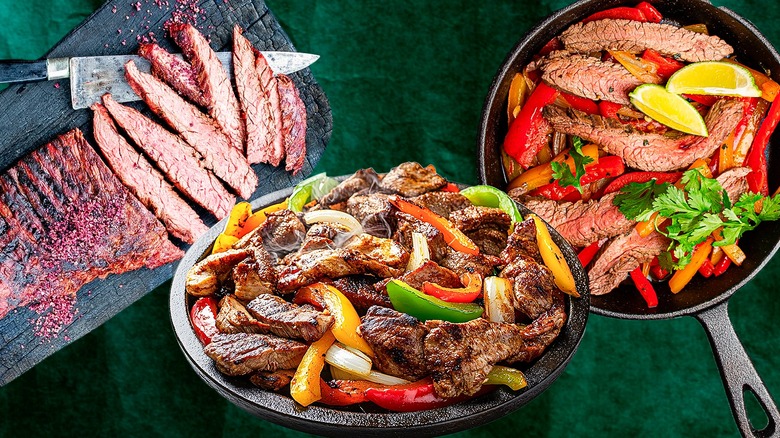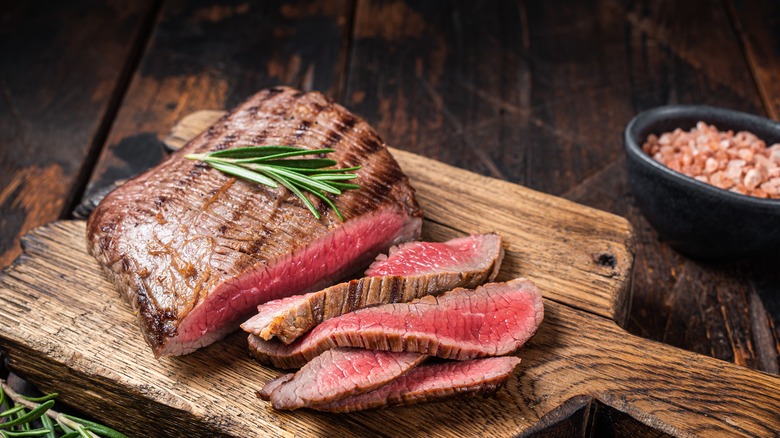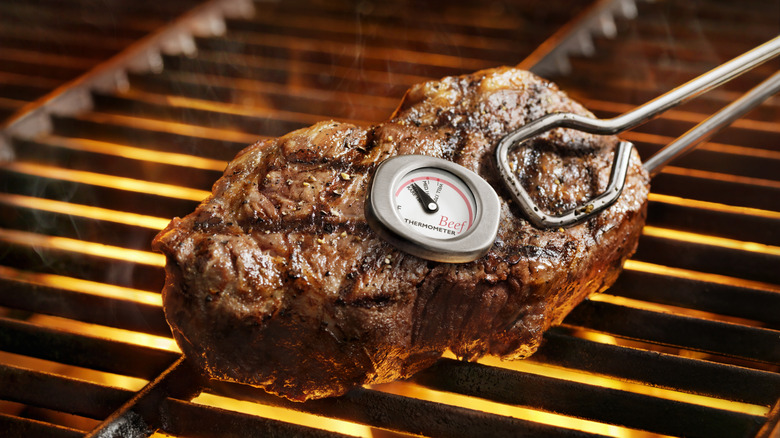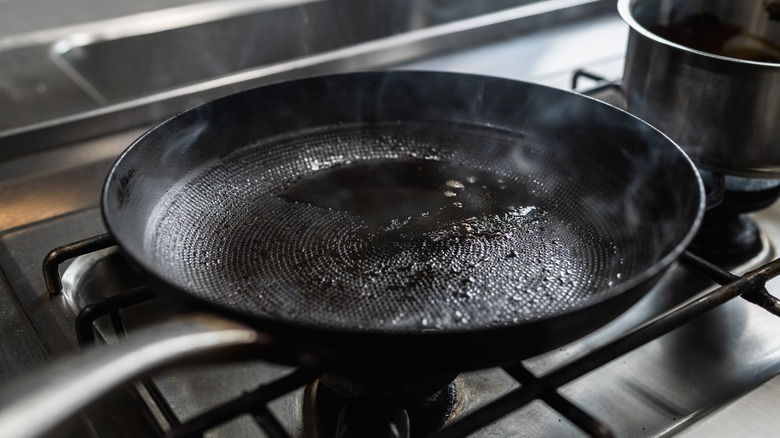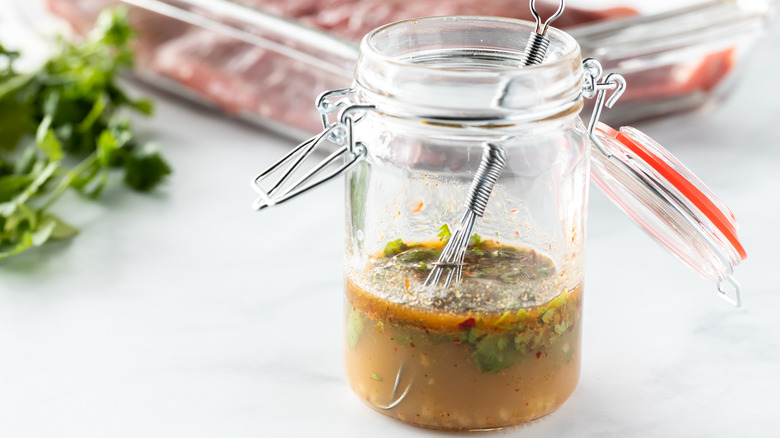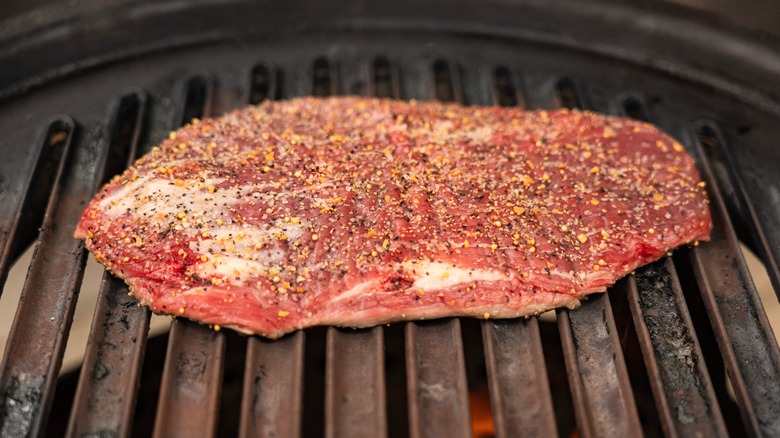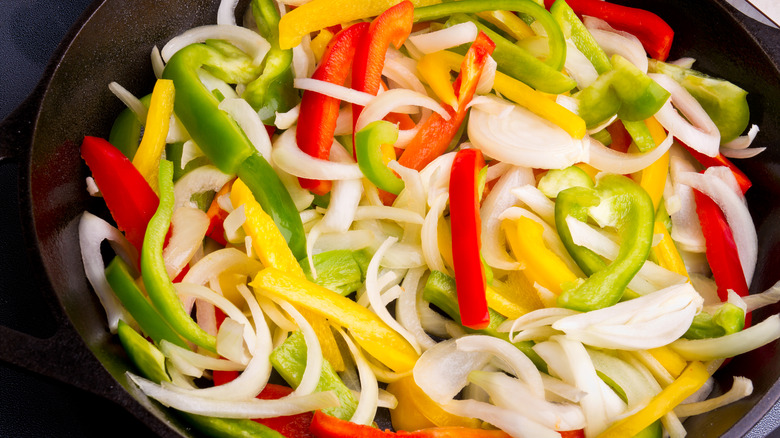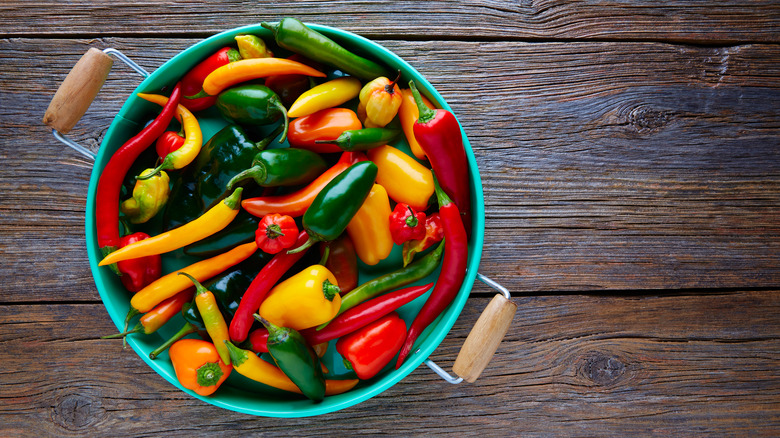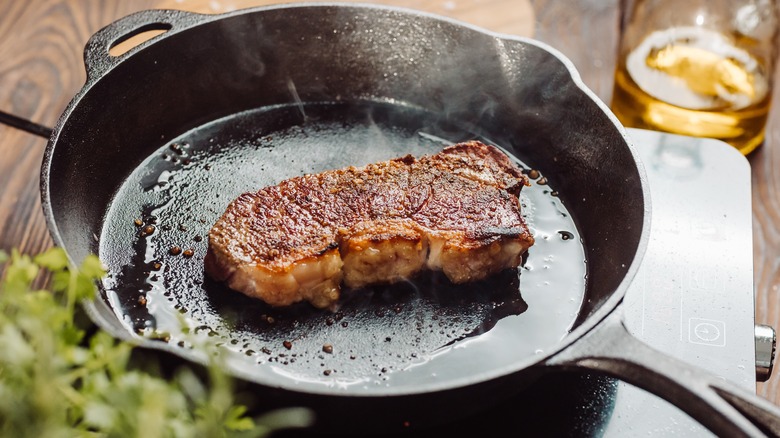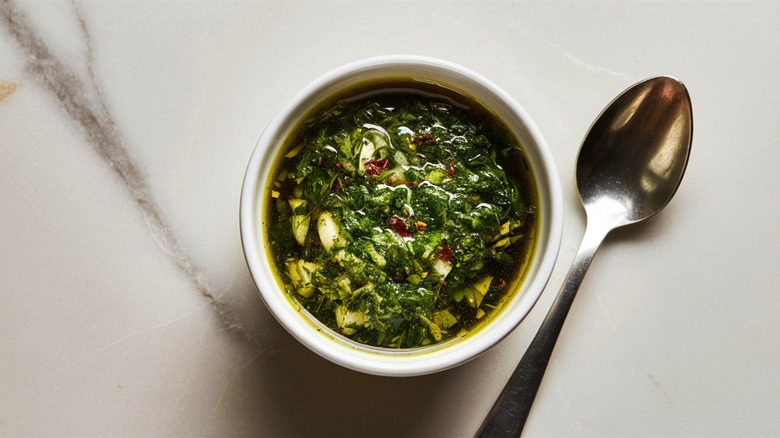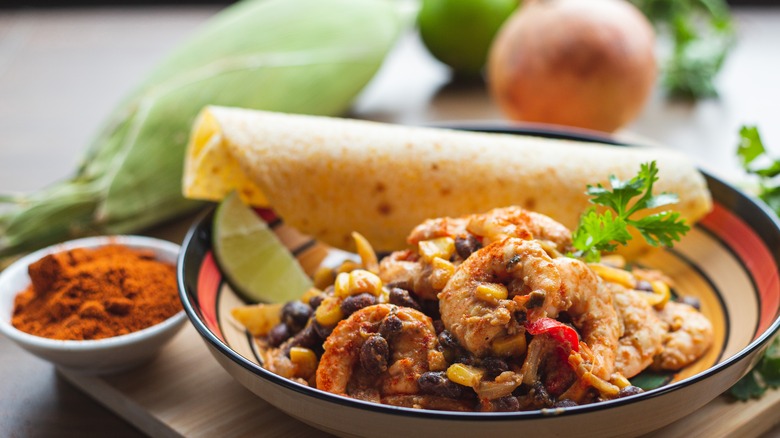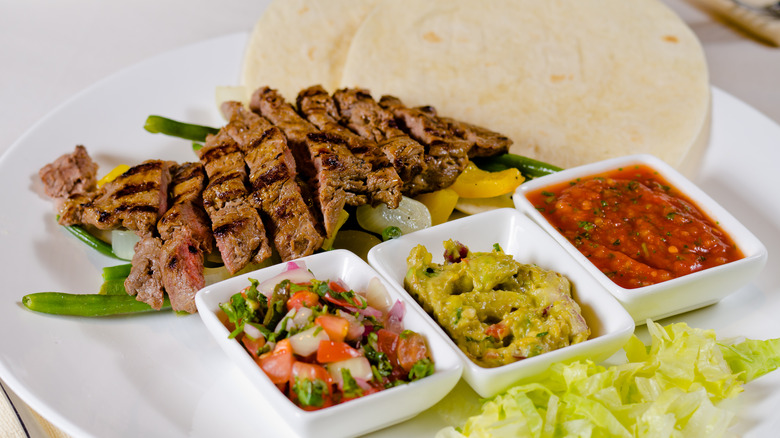11 Tips For Making Sizzling Steak Fajitas At Home
Fajitas are a fantastic family meal that is likely to put a smile on everyone's face. While there are so many variations, from chicken to vegetable, making fajitas with steak upgrades it to a meal that feels a bit more special and indulgent. The smoky, charred flavor of the steak complements the seasoned veggies perfectly, but if you are going to the expense of buying a good steak, you want to make sure you get it spot on.
To help you avoid the most common pitfalls and create the best possible steak fajitas, I asked two experts to share their favorite tips. Yvette Marquez-Sharpnack is the founder of Mexican food blog Muy Bueno and author of "Muy Bueno Fiestas," and Troy Guard is owner and executive chef at TAG Restaurant Group. Between them, they have years of experience in the kitchen, and armed with their advice, you can upgrade your steak fajitas from average to amazing. So grab your sharpest knife and get ready to impress your family with the best steak fajitas they have ever tasted.
Choose the correct cut
One of the most crucial components of delicious steak fajitas is choosing the correct cut of meat. As all steak lovers know, the best cut depends on each dish and how it is being cooked, since some cuts need longer cooking times than others. One cut that strikes the balance between affordability and flavor is flank steak, and both experts agree that it is a great option for fajitas.
"My personal favorite is a skirt steak or flank steak," says Troy Guard. "They're both great pieces of grilling meat. They are not overly expensive cuts, take marinades well, and have a lot of really good flavor when cooked properly." Flank steak has a strong, meaty taste that will stand up to the bold flavors of the fajitas and is a little thicker than skirt, making it less likely to be overcooked.
Yvette Marquez-Sharpnack is also a fan of flank steak but has a more premium option that she turns to, too. "For an affordable option, I usually use beef flank steak, but if I want to be fancy, I'll use sirloin." Sirloin is a juicy, tender option that is also ideally suited to fajitas but comes in at a higher price point. If you're cooking a meal for a special occasion, pushing the boat out with sirloin is a good option, but for a tasty midweek meal, flank steak will result in tasty fajitas at an affordable price.
Don't overcook the steak
No matter what dish you are preparing, overcooking steak is a culinary faux pas that must be prevented at all costs. When asked what common mistakes home cooks make with fajitas, both Troy Guard and Yvette Marquez-Sharpnack admitted that overcooking the steak was near the top of the list. The nature of fajitas means that thin pieces of meat are needed, so Guard recommends keeping a close eye on the steak to keep it moist and flavorful.
Overcooked steak fajitas will be dry and tough, ruining the dish and leaving everyone feeling disappointed. Aim to cook the steak to medium at the very most, ideally medium-rare instead. If you don't feel confident guessing when the steak is cooked, a meat thermometer can keep you right. You want to reach around 130 degrees Fahrenheit for medium rare, and 135 degrees for medium.
Another often-overlooked tip when cooked steak is to allow it to rest once it has finished cooking. As meat cooks, the juices move into the center of the meat, so leaving it for a few minutes afterward will allow those lovely juices to move back to where they belong and return the succulence to every bite.
Use a hot pan
Before you add your meat to the grill or pan, it is essential that you get the cooking surface as hot as possible. One of the prevailing flavors in steak fajitas is the char, and without it, your meat will simply not live up to expectations. If you're using a skillet, cast iron is a great option — then add a little oil, and once you see it beginning to smoke, you will know it's time to add the steak.
"It's important to get the pan or grill hot before adding the meat," says Troy Guard. "With a pan brought up to temperature before adding the steak, you should still be able to get that hard sear and a little char you're looking for in fajitas."
If you're grilling the steak outside, the same rule applies. A smoking hot grill will give the meat the signature chargrilled marks that everyone looks for, as well as the smoky flavor that will complement the spices and seasoning of the fajitas. A super hot pan or grill will also help you to cook the steak properly. By searing the outside hard and fast, you can take the steak off the heat while the middle is still pink. On the other hand, cooking on a lower heat means that by the time the outside is nicely cooked, the meat in the middle will have overcooked and turned gray — not what you want for sizzling fajitas.
Marinate the meat
To marinade or not — that is the question. And funnily enough, the answer is — it's completely up to you. The experts were in agreement that marinating the steak is not essential to producing delicious steak fajitas, but they both felt that it could definitely enhance the meat, making it worth the extra effort if you have the time.
"It is not necessary, but a simple seasoning of garlic, lime juice, olive oil, chili powder, salt, and black pepper would be great," suggests Yvette Marquez-Sharpnack. "My go-to bottle of marinade is Claude's Fajita. I grew up in El Paso and this product is from El Paso and tastes like good ol' Texas!"
A marinade can be especially beneficial if you have opted for a less tender cut of steak, such as flank. Compared to sirloin, flank has less marbling and can be tougher, meaning a marinade containing acid can help break the fibers down before cooking. If you are opting for a marinade, it makes sense to include seasoning that matches the ingredients and cuisine of the fajitas. "Simple salt and pepper can go a long way, but I like to make a marinade with lime juice, chili powder, cumin, Mexican oregano, and a little bit of beer," advises Troy Guard. Whether you marinate the meat or not, you should always pat the steak dry before cooking. This will increase the chances of the steak forming that perfect sear as soon as it hits the hot pan.
Season the meat
Every home cook knows that seasoning is the key to delicious food, and this goes beyond the usual twist of salt and pepper. For steak fajitas, both of these basic seasonings are crucial, so don't skip them. But with a little creativity, you can enhance the boldness of flavor and make something truly special.
First of all, don't go out and buy a jar of fajita seasoning. I'm all for culinary shortcuts when it makes sense — store-bought pastry is a good example — but please don't pay $4 for someone to mix together spices that you already have in your pantry! Have a root around in your cupboards, and see which spices you can find. As long as you have a few, like paprika, cumin, garlic powder, chili powder, and coriander, you can make your own delicious homemade fajita seasoning. Mix the spices together, add some dried oregano, too, if you have some, and rub onto the steak, covering every inch of the meat. If you are planning to marinate the steak, you can either add the seasoning to the marinade or wipe the marinade off before cooking and add the fajita mix. Be sure to make a large batch and store in an airtight jar so that you have the mix on hand the next time you are making fajitas, or just need a punchy seasoning for your meat.
Be creative with the veggies — but keep them crunchy
When it comes to choosing vegetables to accompany your steak, you can pretty much tailor them to whatever you are in the mood for, or the produce you have in the fridge. When asked what vegetables she likes to use, Yvette Marquez-Sharpnack said, "I like the classics — colorful sauteed bell peppers and grilled onions." These two veggies are found in virtually every serving of fajitas, and for good reason. Between them, they offer freshness and acidity to cut through the rich steak, and fajitas simply wouldn't be the same without them.
Just because peppers and onions are classic, though, doesn't mean you have to limit yourself to just those vegetables in fajitas. You could also add black beans for extra protein, roasted sweet potato, or even some mushrooms.
Troy Guard warns, however, about being careful when cooking the vegetables, as there is no point in cooking the steak to precision only to spoil it with soggy veggies. "I see home cooks overcook the fajita vegetables. You want them to still have some texture and crunch." Treat the vegetables in the same way as the meat — cook them in a hot pan to get some delicious char on the outside, but don't allow them to soften too much. Once they are cooked al dente, you can always remove them from the pan and then reheat them for a minute or so just before serving.
Throw in a variety of chiles for some extra heat
One of the best things about fajitas is its versatility. If you are not a fan of intense chili heat, you can keep it subtle with paprika and cumin. However, it you love your dishes to pack a fiery punch, you can add whatever chiles you like.
Troy Guard is a fan of mixing up the heat of his fajitas in addition to the usual veggies you would expect. "Onion and green bell pepper are what you traditionally see, but I like to also add poblanos and jalapeños," he explains. Poblano peppers are a great option if you want a flavorsome note without too much fiery heat. They measure around 1,000-1,500 on the Scoville scale, meaning your taste buds should be safe enough if you throw a few into your fajitas. Jalapeños are a notch up, at between 2,500 and 8,000 units. This is enough to really shine through the dish and complement the meat without blowing your palate away.
However, if heat is what you are craving, why not try a Scotch Bonnet, which sits further toward the top of the scale on 100,000 units? If you've never tried it before but fancy the challenge, remove all of the seeds and white membrane before you cook it, as these contain the highest concentrations of capsaicin, which is the compound that will be responsible for bringing you out in a sweat. You may also want to use gloves to prepare them — just in case.
Use a cast iron skillet if cooking indoors
In a perfect world, steak fajitas would be made on an outdoor grill every time, to ensure that wonderful charred flavor was always present. Some of us are not lucky enough to live in a part of the world where that is possible year-round, but there is no reason you can't enjoy this Tex-Mex classic even in the winter months.
Yvette Marquez-Sharpnack sees no reason that you can't cook fajitas indoors, admitting, "I am obsessed with my large cast iron skillet." Cast iron is the ideal material for searing meat, as it retains its heat really well. This means that once it has heated up sufficiently, you can add the steak to the smoking-hot surface and get the same delicious sear that you would expect from an outdoor grill. If you are not used to working with cast iron, it can take longer to heat up than you are used to with a non-stick aluminum pan. You will need to pre-heat the pan for up to five minutes before adding the steak. To check if it is hot enough, add a sprinkle of water. If it pops and you hear it sizzling straight away, you are good to go.
If you don't have a cast iron skillet, Troy Guard points out that a saute pan will work, too. Whatever pan you use for your steak fajitas, just be sure to get it as hot as you can before adding the meat to try and replicate the charred flavor of the grill, without overcooking the meat inside.
Customize the accompaniments with some chimichurri
Although fajitas are very firmly a Tex Mex dish and benefit from being accompanied by Southern and Mexican flavors, there is nothing to say you can't customize them by adding inspiration from other cuisines, as Yvette Marquez-Sharpnack does with a classic Argentinian sauce. "I like to serve steak fajitas with chimichurri sauce," she admits, and this sounds like a fantastic twist on a classic dish.
Chimichurri is packed with fresh herbs that bring a zesty element to fajitas, and it is used regularly on meat in Argentina. The best thing is it is so easy to make, so you can whip it up quickly while the rest of the dish is cooking.
To create a vibrant homemade chimichurri, chop a generous handful of fresh cilantro and parsley, mince a few cloves of garlic, then add to a small food processor with olive oil, lime juice, and dried cumin. You can add some honey to balance out the sour notes, and a twist of salt and pepper will complete the seasoning. Blend it all together to create a beautiful bright green sauce that will look striking when drizzled over the steak.
Customize them with your favorite ingredients
Just because fajitas are a family favorite with familiar ingredients doesn't mean you can't customize them to suit your needs. Whether you want to make them with filet mignon for a special date night or simply add in some extra ingredients that you have in the fridge, steak fajitas are the type of dish that can handle plenty of variations.
"At my steakhouse, Guard and Grace in Houston, we have really elevated fajitas with our Millionaire Fajitas," explains Troy Guard. "They include oak-grilled gold-grade wagyu flank steak with grilled lobster tail, bone marrow, king crab queso, charro beans, a house-made tortilla, and salsa." While Millionaire Fajitas may be just out of your budget for a midweek dinner, don't be afraid to add your favorite ingredients to make the dish even better than usual.
If you want to up the nutrient profile of an already pretty healthy dish, there are plenty of options you can add to your steak fajitas. Throwing some spinach or kale in at the end of cooking to wilt it slightly is a great way to add leafy greens to the dish, and it really won't affect the flavor much at all. For some plant-based protein, black or kidney beans will make the dish hearty and filling while keeping with the Southwestern vibe.
Or, if you are in the mood for a luxurious surf and turf, add some plump king prawns as a delicious seafood addition. Whatever you fancy adding to your fajitas, this dish is so adaptable that you can change it each time you make it until you find the ideal combination for you and your family.
Remember the classic toppings
In spite of all this talk about customizing steak fajitas, the people you are eating with are likely going to be pretty disappointed if they don't see a few of the classic accompaniments around the table when you serve. "I love all the classics, such as guacamole, salsa, and flour tortillas," reveals Yvette Marquez-Sharpnack.
The key to making steak fajitas more than just an ordinary midweek dinner is to focus on homemade accompaniments that, while familiar, will stand out from the store-bought versions that many people are used to. Homemade guacamole stands head and shoulders above its store-bought counterpart, and the creaminess of fresh avocado just can't be matched. Homemade salsa is also simple to make, and using fire-roasted tomatoes will add a delightful smoky element that the fajitas will love.
Fajitas are the ultimate family dinner, served in the middle of the table with everyone helping themselves, customizing them to their own preference, and arguing over the last of the cheese. The most important thing is to enjoy making them and have even more fun eating them. "It can be a really versatile dish, so I would tell people to make them how they like them with the flavors they enjoy," says Troy Guard. "At home, I keep it simple and use classic toppings like sour cream, cilantro, some really good salsa, and shredded cheese."
